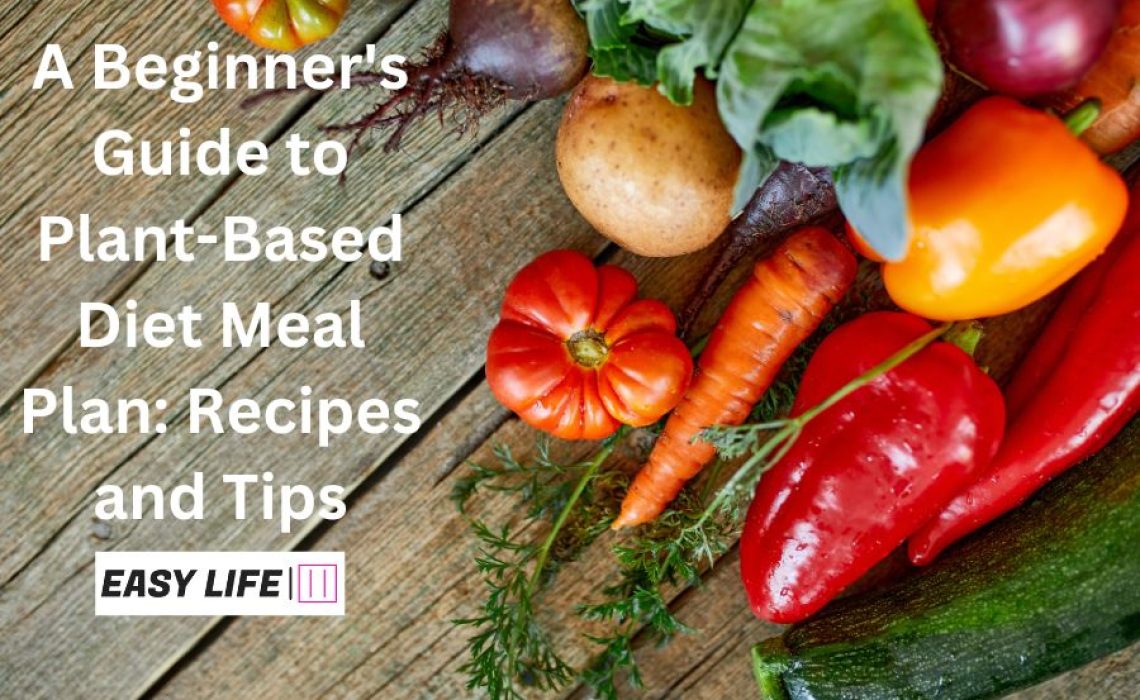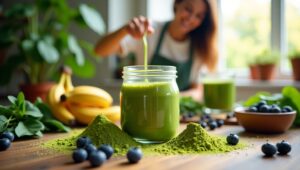If you’re new to a plant-based diet meal plan, you may be wondering what a typical day on this diet looks like. A plant-based diet is focused on whole, unprocessed plant foods such as fruits, vegetables, legumes, whole grains, nuts, and seeds. In this blog, we will provide you with a comprehensive plant-based diet meal plan for beginners, complete with tips and delicious recipes.
Table of Contents
ToggleBenefits of a Plant-Based Diet
A plant-based diet is a way of eating that focuses on whole, unprocessed plant foods like fruits, veggies, legumes, whole grains, nuts, and seeds while limiting or getting rid of animal products.
Here are some of the good things about eating mostly plants:
Reduced risk of chronic diseases
Chronic diseases like heart disease, diabetes, and cancer are less likely to happen in people who eat mostly plants. This is because plant-based meals are high in fibre, antioxidants, and other good for your health nutrients.
Improved digestion
Plant-based meals have a lot of fiber, which is good for the digestive system and can keep you from getting constipated. Plant-based diets have also been linked to a healthier microbiome in the gut, which can help digestion and general health.
Better weight management:
Plant-based diets often have fewer calories and less fat than diets that include animal products. This makes them a good way to control your weight and avoid becoming obese.
Environmental sustainability:
Diets that are mostly made of plants are better for the earth than diets that are mostly made of animal products. Animal farming is a big cause of greenhouse gas emissions, deforestation, and water pollution. Changing to a plant-based diet can help lessen these negative effects on the environment.
Animal welfare
Plant-based meals are a way to help animals and make sure they don’t suffer as much as they do now.
Overall, a plant-based diet can bring several health and environmental benefits, making it an excellent choice for people who want to improve their health while reducing their environmental impact.
What to Include in a Plant-Based Diet Meal Plan
A plant-based diet emphasizes entire, unprocessed plant foods such as fruits, vegetables, legumes, whole grains, nuts, and seeds.
Here are some key elements to include in a plant-based diet meal plan:
Fruits:
Include fresh and frozen fruits in your meals and snacks. Berries, bananas, apples, oranges, and other fruits and vegetables are examples.
Vegetables:
At each meal, aim to fill half of your plate with veggies. Include leafy greens, cruciferous veggies, and starchy vegetables like sweet potatoes in a variety of colors and varieties.
Legumes:
Beans, lentils, chickpeas, and peas are examples. They are high in plant-based protein, fiber, and other nutrients.
Whole grains:
Quinoa, brown rice, oats, and whole wheat products are examples. They are high in fiber and other nutrients and can give you energy all day.
Nuts and seeds:
Include a variety of nuts and seeds such as almonds, walnuts, chia seeds, and flax seeds. They are high in healthy fats, protein, and other essential nutrients.
Plant-based milk and yogurt:
Almond milk, soy milk, coconut milk, and plant-based yogurt are examples. They can be used in place of dairy products in recipes.
Healthy fats:
Avocado, olive oil, and coconut oil are examples. They provide a good dose of beneficial fats, which are necessary for overall health.
Plant-based protein sources:
To ensure that you’re getting enough protein, including tofu, tempeh, seitan, and other plant-based protein sources in your meals.
By incorporating these key components into your plant-based diet meal plan, you can guarantee that your body receives all of the nutrients it requires to thrive.
A One-Week Plant-Based Diet Meal Plan
A plant-based diet emphasizes foods derived mostly from plants, such as fruits, vegetables, whole grains, legumes, nuts, and seeds. This diet is high in fiber, vitamins, minerals, and antioxidants, and it has been linked to a variety of health benefits, including enhanced heart health, weight management, and a lower risk of chronic diseases.
If you’re thinking about switching to a plant-based diet, make sure you plan your meals carefully to ensure you’re getting all the nutrients your body need. To get you started, here’s a one-week plant-based diet meal plan:
Monday:
Breakfast: Vegan banana pancakes made with mashed banana, oat flour, almond milk, and topped with fresh berries and maple syrup.
Mid-morning snack: A small bowl of mixed nuts and dried fruit.
Lunch: Vegan chickpea salad sandwich made with mashed chickpeas, avocado, red onion, and lettuce on whole-grain bread. Side of roasted sweet potato wedges.
Afternoon snack: Sliced cucumbers with hummus.
Dinner: Vegan lentil shepherd’s pie with a mashed sweet potato topping. Side of steamed broccoli.
Tuesday:
Breakfast: Vegan tofu scramble with diced peppers, onions, and spinach. Whole-grain toast with avocado.
Mid-morning snack: A small bowl of fresh berries.
Lunch: Vegan black bean burrito bowl with brown rice, black beans, roasted peppers, avocado, and salsa.
Afternoon snack: Apple slices with almond butter.
Dinner: Vegan lentil and vegetable soup with a side of whole-grain bread.
Wednesday:
Breakfast: Vegan chia seed pudding made with almond milk and topped with fresh fruit and granola.
Mid-morning snack: A small bowl of edamame.
Lunch: Vegan roasted vegetable wrap with hummus, roasted veggies, lettuce, and whole-grain wrap.
Afternoon snack: A small bowl of mixed berries.
Dinner: Vegan stuffed bell peppers with quinoa, black beans, and roasted vegetables.
Thursday:
Breakfast: Vegan protein smoothie with spinach, banana, almond milk, and chia seeds.
Mid-morning snack: A small bowl of mixed nuts and dried fruit.
Lunch: Vegan tempeh and vegetable stir-fry with brown rice.
Afternoon snack: Sliced bell peppers with hummus.
Dinner: Vegan lentil and vegetable curry with quinoa.
Friday:
Breakfast: Vegan oatmeal with almond milk, mixed berries, and sliced almonds.
Mid-morning snack: A small bowl of fresh fruit.
Lunch: Vegan sweet potato and black bean tacos with avocado and salsa on corn tortillas. Side of grilled vegetables such as bell peppers, onions, and zucchini.
Afternoon snack: A small bowl of air-popped popcorn.
Dinner: Vegan eggplant parmesan with a side of mixed greens salad.
Saturday:
Breakfast: Vegan breakfast burrito with tofu, black beans, roasted vegetables, and salsa on a whole-grain tortilla.
Mid-morning snack: Sliced apples with almond butter.
Lunch: Vegan mushroom and spinach risotto.
Afternoon snack: A small bowl of mixed berries.
Dinner: Vegan lentil and vegetable chili with a side of whole-grain bread.
Sunday:
Breakfast: Vegan tofu scramble with diced peppers, onions, and spinach. Whole-grain toast with avocado.
Mid-morning snack: A small bowl of edamame.
Lunch: Vegan quinoa and vegetable stir-fry.
Afternoon snack: Sliced bell peppers with hummus.
Dinner: Vegan vegetable lasagna with a side of mixed greens salad.
This one-week plant-based diet meal plan provides a variety of plant-based protein sources,
Tips for Eating Out on a Plant-Based Diet
Eating out on a plant-based diet might be difficult, but many restaurants provide great plant-based options. Here are some pointers for eating out while following a plant-based diet:
1. Do your homework:
Before visiting a restaurant, look over the menu online to see if there are any plant-based options. You can also look at online reviews or social media to see whether others have found plant-based options at the restaurant.
2. Look for vegetable-based foods:
Many restaurants serve vegetable-based recipes that are easily veganized. Look for dishes with vegetables, grains, and legumes as the main ingredients.
3. Request substitutions:
Don’t be hesitant to request that animal-based elements be replaced with plant-based ones. For example, you can substitute avocado for cheese or tofu for meat.
3. Keep an eye out for hidden animal-based ingredients:
Some recipes may contain animal-based ingredients like chicken or cow broth. Inquire with the server about the ingredients and cooking methods used in the dishes you’re thinking about ordering.
4. Choose ethnic foods:
Many ethnic cuisines, such as Indian, Middle Eastern, and Thai, provide inherently flavorful and delightful plant-based options. Be daring and try different dishes!
5. Be prepared:
If you’re heading to a restaurant with few plant-based alternatives, eat a snack or small meal beforehand to avoid being tempted to make bad choices.
If all else fails, you may always bring your own plant-based dinner or snack to consume at the restaurant.
Following these guidelines will allow you to enjoy eating out on a plant-based diet without jeopardizing your health or ethics. Remember that it is acceptable to request changes and alternatives, and be wary of concealed animal-based substances.
Recipes for plant-based diet plan meals
Sure, here are some delicious and easy plant-based recipes to add to your meal plan:
1. Vegan Lentil Shepherd’s Pie:
Ingredients:
- 1 onion, diced
- 2 carrots, diced
- 2 cloves garlic, minced
- 1 cup lentils, cooked
- 1 cup vegetable broth
- 1 tsp thyme
- Salt and pepper, to taste
- 4 cups mashed sweet potatoes
Instructions:
- Preheat the oven to 375°F (190°C).
- In a large skillet over medium heat, sauté the onion and carrots until softened, about 5 minutes.
- Add the garlic and cook for an additional minute.
- Add the cooked lentils, vegetable broth, thyme, salt, and pepper. Simmer for 10 minutes.
- Transfer the lentil mixture to a baking dish and top with mashed sweet potatoes.
- Bake for 30 minutes, or until heated through.
2. Vegan Black Bean Burrito Bowl:
Ingredients:
- 1 cup cooked brown rice
- 1 can black beans, rinsed and drained
- 1 red bell pepper, diced
- 1 avocado, sliced
- 1 tomato, diced
- 1/4 cup chopped cilantro
- 1/4 cup salsa
- 1/4 cup vegan sour cream
- Salt and pepper, to taste
Instructions:
- In a bowl, mix together the cooked brown rice and black beans.
- Add the diced red bell pepper, sliced avocado, diced tomato, and chopped cilantro.
- Drizzle with salsa and vegan sour cream.
- Season with salt and pepper, to taste.
3. Vegan Lentil and Vegetable Curry:
Ingredients:
- 1 onion, diced
- 2 cloves garlic, minced
- 1 tsp ginger, minced
- 1 can chickpeas, rinsed and drained
- 1 cup cooked lentils
- 1 can diced tomatoes
- 1 can coconut milk
- 2 cups mixed vegetables (such as bell peppers, zucchini, and eggplant)
- 1 tsp curry powder
- Salt and pepper, to taste
Instructions:
- In a large skillet over medium heat, sauté the onion, garlic, and ginger until softened, about 5 minutes.
- Add the chickpeas, cooked lentils, diced tomatoes, coconut milk, mixed vegetables, curry powder, salt, and pepper. Stir to combine.
- Cover and simmer for 15-20 minutes, or until the vegetables are tender.
These recipes are packed with flavor and nutrients, making them a great addition to your plant-based diet meal plan.
Conclusion
Finally, a plant-based diet can provide numerous health and well-being benefits. To guarantee proper consumption of key vitamins, minerals, and fiber, it is critical to eat a range of nutrient-rich foods such as fruits, vegetables, whole grains, legumes, and nuts. Making a meal plan that includes these foods can help you stick to a plant-based diet. Eating out may be pleasurable and satisfying with a little forethought and preparation. And it’s easy to see how savoury and satisfying this way of eating can be with delicious and simple plant-based recipes like the ones given. You may enhance your health and lessen your environmental impact by committing to a plant-based diet while enjoying a great and broad choice of meals.
FAQ
Here are some frequently asked questions about plant-based diets:
1. What is a plant-based diet?
A plant-based diet emphasizes whole, minimally processed foods such as fruits, vegetables, whole grains, legumes, nuts, and seeds. It usually restricts or eliminates animal goods like as meat, dairy, and eggs.
2. Is a plant-based diet healthy?
Yes, when done correctly, a plant-based diet may be quite healthful. It has been found in studies to reduce the risk of chronic diseases such as heart disease, type 2 diabetes, and several types of cancer. However, it is critical to ensure that you are receiving enough protein, iron, calcium, and vitamin B12.
3. Can I get enough protein on a plant-based diet?
Yes, it is possible to get enough protein on a plant-based diet by eating a variety of protein-rich plant foods like legumes, nuts, seeds, and whole grains. You can also consider incorporating plant-based protein supplements like protein powders or shakes if needed.
4. Is a plant-based diet more expensive?
No, not always. When you focus on whole, barely processed foods, plant-based diets can be very cheap. Meat and dairy items tend to cost more than beans, lentils, and whole grains. You can also save money by buying in bulk and going to farmer’s markets.
5. Can I eat out on a plant-based diet?
Yes, you can eat out even if you only eat plants. Many places now have options that are made from plants, and you can also change dishes to fit your diet. You can also study ahead of time to find restaurants that serve plant-based food.
6. Can children follow a plant-based diet?
Yes, children can eat a plant-based diet, but it’s important to make sure they get enough calories for their growing bodies. Talk to a paediatrician or certified dietitian to make sure your child’s nutritional needs are being met.









